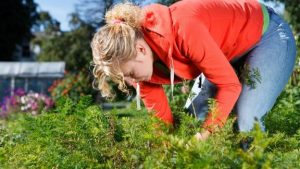Gardening is one of the joys of life for many of us, good for the soul and great for your mental health but pain can disrupt your best-laid plans. The most common gardening-related injuries include
neck and lower back pain, shoulder, elbow and wrist pain
These are mostly overuse injuries that tend to occur after long hours of unfamiliar work, in awkward positions.
Here are some tips and strategies that have helped clients of Southside Physiotherapy Clinic prevent injury while enjoying gardening over the years.
Warm up first
Gardening can be a real workout, so warming up your muscles first is a good idea. Try a brisk five-minute walk and some stretching exercises. One relatively gentle stretch is the knee roll exercise, in which you lie down on your back, then rotate your knees right and left. If you have back pain, work with your Chartered Physiotherapist to find the right stretches for you.
Plan ahead and set realistic goals
Don’t expect to get all your gardening done on the first sunny day of Spring. Set realistic goals. Less is more. Vary your tasks and rotate every 15 mins. Avoid rushing to complete a big project in a short period of time. Vary the different jobs by rotating between pruning, raking, digging, or pulling weeds.
Take breaks every 15 minutes
Your spine is designed to move in all directions, but the forward bending nature of many tasks in the garden means that you may spend much more time in this position than any other. It’s easy to lose track of time in the garden. Set a timer on your phone so that it reminds you stand up and bend backwards and then side bend your spine every 10-15 minutes. Just a minute of this is all that is needed. The secret is a little often.
Consider your body position with each task
When pruning, have the plant in front of you, rather than to the side or at an angle, and avoid over reaching. The closer you are to something the less stress you are placing on your body.
Lift carefully
It’s easy to lift heavy pots, bushes, and full watering cans incorrectly and damage your back.
To lift correctly, begin by squatting, not bending at your waist. Use both hands to hold the object, keeping it close to your body, and slowly straighten your legs as you lift.
To minimize lifting, use a wagon, a dolly, or other aid to carry heavy items from place to place. Half fill large watering cans and consider alternative watering options, such as a hose.
Sharing the lift whenever possible.
Get support from kneelers and chairs
Getting down on the ground—and back up—can be painful or even impossible, depending on your level of pain and flexibility. Heavy-duty kneelers, especially those with raised, padded handles to help you get up and down, allow you to use your arm strength to aid in the process. Kneelers usually include a well-cushioned base to reduce stress and impact on your knees and back. Many kneelers also convert to a low chair.
Check your lawnmower
You may need to consider a motored mower rather than a manual one if you have a history of back pain. The motored ones glide easier along the grass, putting less pressure on your back and arms. Another consideration would be a mulcher which eliminates the need for emptying the cut grass.
Try out specialized tools
Long-handled tools can eliminate much of the bending required by planting and weeding. Long-handled trowels and cultivators can be helpful if bending forward causes or worsens your back pain.
Garden while standing
Wall gardening, also called vertical gardening is a trend of planting up, not across the ground. If bending is painful for you, working more at your eye level may be something to consider.
How to rest when you’re finished
When you have finished gardening, don’t collapse into a soft and low sofa. Instead, lie on the sofa, walk around the block or sit on a dining room style chair to rest. When your body is in the same position for a long time, e.g. forward bent, the soft tissue structures (muscles and ligaments) gradually lengthen and temporarily weaken. If you sit immediately without letting them gradually return to normal, you may find it hard to get up from the sofa.

